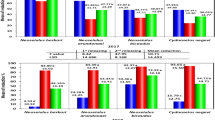Abstract
Damages caused by the larvae of Byturus tomentosus (Coleoptera: Byturidae) are a big problem of European raspberry production. Under integrated pest management conditions in Switzerland, B. tomentosus is controlled by chemical-synthetic insecticides. In organic production, no corresponding insecticides are permitted. White sticky traps (type Rebell® bianco) are used for monitoring purposes. Can glue-traps also be used for mass-trapping and damage control? In this study, the attractiveness for adult B. tomentosus of one yellow and several white glue-traps was compared by counting the trapped individuals. Trapped beneficial insects like honey bees, Coccinellidae, Syrphidae and Chrysopidae were also counted. The contamination of the traps caused by other non-target arthropods was measured by a computer-assisted method. The white sticky trap type Rebell bianco was the most attractive for B. tomentosus. The attractiveness for the beneficials was relatively low, except when too much glue was applied on the traps, then the attractiveness for honey bees increased significantly. In this study, traps, which were placed in high densities (17 traps per 100 m2), significantly decreased the damages caused by larvae by around 40%. The trapping method does not cause any residuals of pesticides on the fruits or soil. Therefore, the trapping method could be an alternative to control B. tomentosus, especially in organic production.

Similar content being viewed by others
References
Antonin RAC (1984) Le ver des framboises, Byturus tomentosus F. Rev Suisse Vitic Arboric Hortic 16:103–105
Birch ANE, Gordon SC, Griffiths DW, Harrison RE, Hughes JP, McNicol RJ, Robertson GW, Willmer PG, Woodford JAT (1996) Responses to flower volatile by raspberry beetle, Byturus tomentosus and field evaluation of white traps for monitoring flight activity. Annual Report of the Scottish Crop Research Institute for 1995, Dundee, pp 144–148
Briggs JB, Danek J, Lyth M, Keep E (1982) Resistance to the raspberry beetle, Byturus tomentosus, in Rubus species and their hybrid derivatives with R. idaeus. J Hortic Sci 57:73–78
Galli P, Epp P, Hoehn H (1993) Investigations on the attractivity of different white coloured traps (type Rebell and type Temmen) for apple sawfly (Hoplocampa testudinea Klug). Erwerbsobstbau 35:91–98
Gordon SC, Woodford AT, Birch ANE (1997) Arthropod pests of Rubus in Europe: pest status, current and future control strategies. J Hortic Sci 72:831–862
Hoehn H (1991) Farbtafeln zur Schädlingsüberwachung im Beerenanbau. Schweiz Z Obst-Weinbau 127:249–252
Hoehn H, Carlen C (2003) Pflanzenschutzliste für die in den Beerenkulturen bewilligten Insektizide, Akarizide und Molluskizide. Eidgenössische Forschungsanstalten Wädenswil und Changins und Schweizerischer Obstverband, Zug, Switzerland
Hoehn H, Neuweiler R, Hoepli HU (1995) Integrierte Schädlingsregulierung bei Himbeeren. Schweiz Z Obst-Weinbau 131:308–310
Schmid K, Hoehn H, Hoepli HU, Graf B (2001) Der Himbeerkäfer geht auf den Leim—Befallsprognose mit Weißfallen. Schweiz Z Obst-Weinbau 137:198–201
Speiser B, Tamm L (2003) Hilfsstoffliste—zugelassene und empfohlene Hilfsstoffe für den biologischen Landbau. Research Institute of Organic Agriculture, Frick, Switzerland
Taylor CE, Gordon SC (1975) Further observations on the biology and control of the raspberry beetle (Byturus tomentosus (Deg.)) in eastern Scotland. J Hortic Sci 50:105–112
Willmer PG, Hughes JP, Woodford JAT, Gordon SC (1996) The effects of crop microclimate and associated physiological constraints on the seasonal and diurnal distribution patterns of raspberry beetle (Byturus tomentosus) on the host plant Rubus idaeus. J Ecol Entomol 21:87–97
Woodford JAT, Gordon SC, Hoehn H, Schmid K, Tuovinen T, Lindqvist I (2000) Monitoring raspberry beetle (Byturus tomentosus) with white sticky traps: the experiences from three geographically distinct European areas. Proc BCPC Conf–Pests Dis 3:321–326
Woodford JAT, Birch ANE, Gordon SC, Griffiths DW, McNicol JW, Robertson GW (2003) Controlling raspberry beetle without insecticides. IOBC Bull 26(2):87–92
Acknowledgements
We thank Bernhard Zemp (Uffikon), Köbi Kaufmann (Ballwil), Ernst Niederer (Berneck) and Fritz Wüthrich (Trubschachen) for permitting the trials to be conducted in their orchards, and we also thank Andermatt Biocontrol AG (Grossdietwil) and Bio-Agrar-Counsel GmbH (Toffen) for providing the traps. This study was funded by the Swiss Federal Office for Agriculture (BLW).
Author information
Authors and Affiliations
Corresponding author
Additional information
Communicated by Heidrun Vogt
Rights and permissions
About this article
Cite this article
Schmid, A., Hoehn, H., Schmid, K. et al. Effectiveness and side effects of glue-traps to decrease damages caused by Byturus tomentosus in raspberry. J Pest Sci 79, 137–142 (2006). https://doi.org/10.1007/s10340-006-0126-9
Received:
Revised:
Accepted:
Published:
Issue Date:
DOI: https://doi.org/10.1007/s10340-006-0126-9




